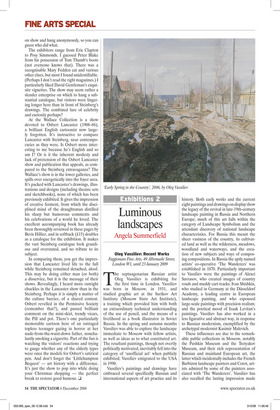Luminous landscapes
Angela Summerfield
Oleg Vassiliev: Recent Works Faggionato Fine Arts, 49 Albemarle Street, London W1, until 23 January 2009
The septuagenarian Russian artist Oleg Vassiliev is exhibiting for the first time in London. Vassiliev was born in Moscow, in 1931, and studied graphic art at the Surikov Art Institute (Moscow State Art Institute), a training which provided him with both an extraordinary technical understanding of the use of pencil, and the means of a livelihood as a book illustrator in Soviet Russia. In the spring and autumn months Vassiliev was able to explore the landscape immediate to Moscow with fellow artists, as well as ideas as to what constituted art. The resultant paintings, though not overtly politically motivated, inevitably fell into the category of ‘unofficial art’ when publicly exhibited; Vassiliev emigrated to the USA in 1990.
Vassiliev’s paintings and drawings have embraced several specifically Russian and international aspects of art practice and its history. Both early works and the current eight paintings and drawings on display show the legacy of the revival in late-19th-century landscape painting in Russia and Northern Europe; much of this art falls within the category of Landscape Symbolism and the attendant discovery of national landscape characteristics. For Russia this meant the sheer vastness of the country, its cultivated land as well as the wilderness, meadows, woodland and waterways, and the creation of new subjects and ways of composing compositions. In Russia the aptly named artists’ co-operative ‘The Wanderers’ was established in 1870. Particularly important to Vassiliev were the paintings of Alexei Savrasov, who created images of country roads and muddy cart-tracks; Ivan Shishkin, who studied in Germany at the Düsseldorf Academy, a leading centre in European landscape painting, and who espoused large-scale paintings with precision realism; and the poetical mood of Isaak Levitan’s paintings. Vassiliev has also worked in a less figurative and abstract way, in response to Russian modernism, exemplified by the archetypal modernist Kasimir Malevich.
These influences are due to the remarkable public collections in Moscow, notably the Pushkin Museum and the Tretyakov Museum, and their rich representation of Russian and mainland European art, the latter which incidentally includes the French Barbizon landscape painters and Corot, artists admired by some of the painters associated with ‘The Wanderers’. Vassiliev has also recalled the lasting impression made upon him by his childhood encounter with Alexander Ivanov’s famous painting ‘Christ Appearing to the People’; its monumental presence within the gallery room and accompanying studies and sketches have influenced Vassiliev’s own art practice. The painting ‘The Sunset’, in the current exhibition, also reminds us that several paintings by the early 19th-century German landscape symbolist painter, Caspar David Friedrich, are part of The Hermitage in St Petersburg, due to the collecting interests of Tsar Nicholas I.
Vassiliev also incorporates Russian text into some of his art works. ‘The White Flowers’, for example, has a poem by Ivan Bunin (1870–1953), a writer of poetry and prose, who was also an émigré leaving for France after the Russian revolution. There are two key aspects of Bunin’s work which inform Vassiliev’s paintings and drawings in general. Bunin painted in words the essence of the Russian countryside and its seasons (a sensibility best understood as the expression of the Russian soul): ‘in winter, a boundless snowy sea; in summer a sea of cornfields, grass, and flowers’. He also, due to his own distressed-nobility background, created characters who existed in a metaphorical twilight tinged with longing for what was and what might have been.
A central theme of Vassiliev’s art, exemplified by the poignant painting ‘The Last Stop’, is the complexities of memory; Vassiliev has described this as ‘the ghost of memory’. Allied to this is Vassiliev’s overriding concern with light; his self-styled ‘abstractionist’ works of the Sixties and Seventies were explorations of ‘the interactions between space-surface-light’. He masters light as though it is part of the very fabric of the surface on which he paints and draws, not as a tonal painter nor through the conventional use of chiaroscuro, which would lead to sharply diverging shadows and contours around forms.
Vassiliev’s understanding of light is used to extraordinary effect both in the coloured pencil drawing on canvas, ‘The Wild Flowers’, and the oil painting ‘The Last Stop’, an image of Moscow’s hinterland. Vassiliev’s images contain their own luminosity, so that the whole painting is itself the subject and expression of light. Even in the seemingly most colourful of paintings, such as ‘Churchyard’, and ‘Early Spring in the Country’ with its touches of deep red among the rain-washed mud ruts, colour appears distilled and abstracted. In ‘Early Spring/High Water’ we have the superb fusion of paint (titanium — the most luminous of whites available to artists) with pencil to create an ethereal world of mists and snow. Leaving the exhibition we are left with our own lasting impressions which linger, as in the artist’s own words, as the ‘living image’. ❑



















































































 Previous page
Previous page